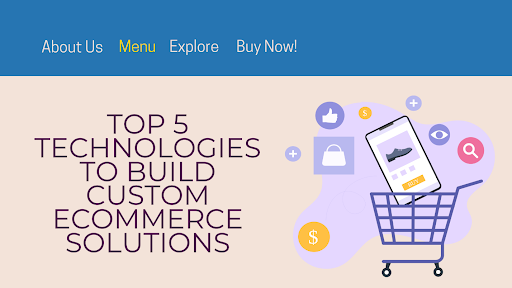
Top 5 Technologies to Build Custom Ecommerce Solutions
Discover the best ecommerce web development frameworks like React Native, Node.js, Django, Spring Boot, and Laravel. Contact Us Now

Discover the best ecommerce web development frameworks like React Native, Node.js, Django, Spring Boot, and Laravel. Contact Us Now
Are you willing to expand your business through e-commerce? If yes, then you need to get scalable ecommerce web development solutions to stay competent in the market.
An e-commerce website is instrumental in increasing their sales and growing their business. So, when working with an e-commerce website development company, it is important to know the technology being used to build your app. It will directly impact the performance, security, and scalability of your platform.
While platforms like WordPress and Shopify are widely used for developing e-commerce websites, they work with ready-made templates and built-in plugins for adding functionalities. However, when working with a web framework, the UI/UX design can be unique for your app. Even functionalities can be added as per your requirement.
Following are some of the best web development frameworks for building ecommerce websites:
Building an e-commerce website using React Native involves creating a cross-platform mobile-friendly application that can give a better user experience. You need to set-up for a React Native environment, using React Native CLI. Choose a backend like Firebase, Node.js, or Django for data management.
When you are working ecommerce website development, implement navigation using React Navigation, integrate payment gateways like PayPal or Stripe. Make sure that proper optimization of performance is made.
Benefits of using React Native:
When you design an e-commerce website using Node.js Technology involves setting up a backend with Express.js, managing a database PostgreSQL or MongoDB. Key steps include handling payments with Stripe or PayPal, setting up authentication, and implementing features of product management.
Benefits of Using Node.js:
Building an e-commerce website using Django involves setting up a Django project, and defining models for users, products, and orders. You can create desired templates for displaying products and integrating payment gateways. Django’s built-in authentication system ensures secure user management and Django ORM makes database operations simple. You can use Django REST Framework to build APIs for a smooth shopping experience.
Benefits of using Django (Python):
When you are doing e-commerce website development using Spring Boot (Java) involves simple steps. First, set up a Spring Boot project with dependencies like Spring Data JPA, Spring Web, and Thymeleaf. Configuration of database (e.g., MySQL) and use JPA/Hibernate for data persistence. Develop REST APIs for products, orders, and users. Integrate payment gateways and ensure security with JWT.
Benefits of using Spring Boot (Java):
Laravel is a powerful PHP framework widely used for building custom ecommerce applications. Many professional ecommerce services providing agencies prefer this to build a robust ecommerce website.
Benefits of using Laravel:
For businesses looking for ecommerce web application development, Laravel offers unmatched flexibility over the entire system.
Choosing the right technology for your ecommerce app is essential for long-term success. If you still feel unsure which technology best suits your business, partnering with a reputable ecommerce website design agency can help you make the right decision. Are you ready to take the next step to boosting your online business?

Web Development Services in the United States